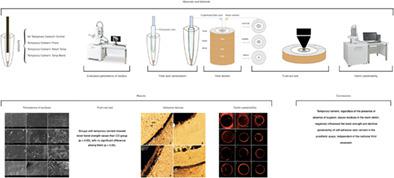当前位置:
X-MOL 学术
›
Microsc. Res. Tech.
›
论文详情
Our official English website, www.x-mol.net, welcomes your
feedback! (Note: you will need to create a separate account there.)
Temporary cement residues affect the bond strength and dentin penetration of self-adhesive resin cement in fiberglass post cementation
Microscopy Research and Technique ( IF 2.0 ) Pub Date : 2021-05-07 , DOI: 10.1002/jemt.23789 Joissi Ferrari Zaniboni 1 , Aryvelto Miranda Silva 1 , Eduardo Fernández 2, 3 , Cristiane de Melo Alencar 1 , Jéssika Mayhara Pereira Morais 1 , Edson Alves de Campos 1 , Milton Carlos Kuga 1
Microscopy Research and Technique ( IF 2.0 ) Pub Date : 2021-05-07 , DOI: 10.1002/jemt.23789 Joissi Ferrari Zaniboni 1 , Aryvelto Miranda Silva 1 , Eduardo Fernández 2, 3 , Cristiane de Melo Alencar 1 , Jéssika Mayhara Pereira Morais 1 , Edson Alves de Campos 1 , Milton Carlos Kuga 1
Affiliation

|
This study evaluated the persistence of eugenol-containing (PR, Provy) or eugenol-free (RT, Relyx Temp, and TB, Temp Bond) temporary cement residues and its effects on push-out bond strength and dentinal penetration of the self-adhesive resin cement (Relyx U200). Eighty human roots were endodontically treated and post space prepared. Fourty specimens were distributed in four groups (n = 10): Control (CO), without any clinical procedure, PR, RT, and TB, where a metallic post was cemented with one of the temporary cements. After metallic post removal, hemi sections post space were submitted to SEM analysis. Another specimens were distributed in similar groups, but fiberglass post was cemented using Relyx U200 cement and submitted to push-out bond strength and dentinal penetration cement analysis, in post space thirds. SEM analysis were evaluated by Kruskal–Wallis and Dunn tests, while bond strength and dentinal penetration were evaluated by ANOVA One-Way and Tukey test (p < .05). Only in apical thirds, PR, RT, and TB showed higher persistence of residues than CO. In bond strength, PR, RT, and TB showed lower values than CO, in all post space thirds (p < .05). But to dentinal penetration, PR, RT, and TB presented lower values than CO only in apical thirds (p < .05). There is the greatest persistence of temporary cement residues only in apical post space third, providing less dentinal penetration of the self-adhesive resinous cement. However, the previous use of temporary cements has negative effects on the bond strength cementation system, regardless of the third evaluated.
中文翻译:

临时水泥残留物影响玻璃纤维后粘接中自粘树脂水门汀的粘结强度和牙本质渗透
本研究评估了含丁香酚(PR、Provy)或不含丁香酚(RT、Relyx Temp 和 TB、Temp Bond)的临时水泥残留物的持久性及其对自粘胶的推出粘合强度和牙本质渗透的影响树脂水泥(Relyx U200)。80 根人类牙根经过牙髓治疗并准备好后间隙。四十个标本分布在四组(n = 10):对照 (CO),没有任何临床程序、PR、RT 和 TB,其中金属柱与其中一种临时骨水泥粘合。去除金属柱后,对柱空间的半切片进行 SEM 分析。另一个样本分布在类似的组中,但玻璃纤维桩使用 Relyx U200 水泥粘合,并在桩间距三分之一处进行推出粘合强度和牙本质渗透水泥分析。SEM 分析通过 Kruskal-Wallis 和 Dunn 测试进行评估,而粘合强度和牙本质渗透通过 ANOVA One-Way 和 Tukey 测试进行评估 ( p < .05)。仅在根尖三分之一处,PR、RT 和 TB 显示出比 CO 更高的残留持久性。在粘合强度方面,PR、RT 和 TB 在所有后三分之一处显示出低于 CO 的值(p < .05)。但对于牙本质穿透,PR、RT 和 TB 仅在根尖三分之一处呈现低于 CO 的值 ( p < .05)。临时骨水泥残留物仅在根尖柱间隙 1/3 中的持久性最大,提供了较少的自粘树脂水泥的牙本质渗透。然而,无论第三次评估如何,之前使用临时水泥对粘结强度胶结系统都有负面影响。
更新日期:2021-05-07
中文翻译:

临时水泥残留物影响玻璃纤维后粘接中自粘树脂水门汀的粘结强度和牙本质渗透
本研究评估了含丁香酚(PR、Provy)或不含丁香酚(RT、Relyx Temp 和 TB、Temp Bond)的临时水泥残留物的持久性及其对自粘胶的推出粘合强度和牙本质渗透的影响树脂水泥(Relyx U200)。80 根人类牙根经过牙髓治疗并准备好后间隙。四十个标本分布在四组(n = 10):对照 (CO),没有任何临床程序、PR、RT 和 TB,其中金属柱与其中一种临时骨水泥粘合。去除金属柱后,对柱空间的半切片进行 SEM 分析。另一个样本分布在类似的组中,但玻璃纤维桩使用 Relyx U200 水泥粘合,并在桩间距三分之一处进行推出粘合强度和牙本质渗透水泥分析。SEM 分析通过 Kruskal-Wallis 和 Dunn 测试进行评估,而粘合强度和牙本质渗透通过 ANOVA One-Way 和 Tukey 测试进行评估 ( p < .05)。仅在根尖三分之一处,PR、RT 和 TB 显示出比 CO 更高的残留持久性。在粘合强度方面,PR、RT 和 TB 在所有后三分之一处显示出低于 CO 的值(p < .05)。但对于牙本质穿透,PR、RT 和 TB 仅在根尖三分之一处呈现低于 CO 的值 ( p < .05)。临时骨水泥残留物仅在根尖柱间隙 1/3 中的持久性最大,提供了较少的自粘树脂水泥的牙本质渗透。然而,无论第三次评估如何,之前使用临时水泥对粘结强度胶结系统都有负面影响。











































 京公网安备 11010802027423号
京公网安备 11010802027423号